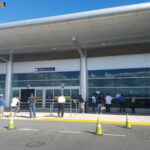Knowing what type of airplane you are scheduled to fly on can enhance your travel experience in several ways. Whether you’re curious about the seat configuration, concerned about specific aircraft models, or simply want to prepare for potential carry-on restrictions, identifying your plane type beforehand is a smart move. Following the Boeing 737 MAX groundings, many travelers are particularly interested in knowing their aircraft.
One practical reason to check your aircraft is baggage allowance, especially for carry-ons. Smaller regional jets and turboprops often have limited overhead bin space, leading to mandatory gate-checking of standard carry-on bags. Opting for a flight on a larger aircraft can ensure your luggage stays with you in the cabin. Similarly, larger planes typically offer more diverse seating options, from upgrades to simply more space, or better chances of families sitting together. Understanding the aircraft type empowers you to make informed decisions about your flight.
So, how exactly do you find out what plane you’ll be flying on? Here are several methods to uncover this information before you even reach the airport.
Discovering Your Aircraft Type During Booking
The most straightforward way to identify your plane type is during the flight booking process itself. Airlines are generally transparent about the aircraft model assigned to each flight. As you browse flight options on an airline’s website or through online travel agencies, look for aircraft details typically displayed alongside flight times and prices. This information is often located just below the flight number and operational details as you select your flights.
For example, when searching for flights from New York to Los Angeles, you will see a list of available flights from different airlines. Clicking on the flight details or expanding the flight information will usually reveal the aircraft type, such as “Boeing 737-800” or “Airbus A320”. This allows you to know What Plane Am I Flying On before finalizing your reservation.
Utilizing Travel Search Engines to Find Aircraft Details
Travel search engines like Google Flights, Kayak, and Expedia also provide aircraft type information. When you conduct a flight search, these platforms aggregate data from various airlines. The aircraft model is usually listed in smaller text beneath the flight segment details, often next to the operating airline.
On Google Flights, after entering your origin and destination and selecting dates, you will see a list of flights. Beneath each flight option, you’ll find details like the airline, flight duration, and aircraft type. Kayak notably added an aircraft filter, allowing users to specifically include or exclude certain aircraft models like the Boeing 737 MAX series, reflecting increased traveler awareness and preferences regarding aircraft types.
Leveraging ITA Matrix for Detailed Aircraft Information
If you’re still unable to find the aircraft type through booking sites or search engines, the ITA Matrix is a powerful tool. This flight search engine, designed for travel professionals, offers in-depth flight details. Simply enter your origin, destination, and travel dates. Once you’ve found your flight, click the “details” arrow to the far right of the flight listing. This will expand to show comprehensive information, including the precise aircraft type you are booked on.
While airlines strive to maintain schedules, aircraft substitutions can occur, especially for bookings made far in advance. Schedule changes or “equipment changes” are more common than day-of aircraft swaps, which are typically reserved for unforeseen circumstances like mechanical issues or weather delays. However, it’s always wise to re-confirm your aircraft type closer to your travel date, especially if it’s a significant factor in your travel plans.
Optimizing Your Seat Selection Based on Aircraft Type
Knowing your aircraft type is incredibly beneficial when it comes to seat selection. It allows you to research seat maps and choose the best seat for your preferences, even identifying the safest seats on an airplane. While aircraft manufacturers adhere to standard layouts for each model, airlines often customize interiors. This customization includes seating configurations, the placement of amenities like galleys and lavatories, and the overall cabin layout. For instance, a budget airline might prioritize maximizing seat count, while a long-haul international carrier might focus on premium cabin experiences and enhanced business class seating. Even within the same airline, variations exist; Delta, for example, operates several configurations of the Boeing 767-300ER.
Before consulting third-party seat map websites, check your airline’s reservation page for a seat map. This will give you an initial idea of the specific configuration for your flight. For detailed seat maps and reviews, websites like SeatGuru and SeatMaestro are invaluable resources. These sites offer detailed fleet maps, highlighting seat features, potential drawbacks (like limited recline or proximity to lavatories), and amenities such as in-flight entertainment and Wi-Fi availability. Knowing the aircraft type empowers you to avoid undesirable seats, such as those with misaligned windows or restricted legroom, and choose seats that best suit your needs.
Common Aircraft Types in the U.S.
The majority of flights within the United States are operated by aircraft from four primary manufacturers: Airbus, Boeing, Bombardier, and Embraer. These manufacturers produce a diverse range of aircraft, each designed for specific operational needs, from short regional routes to long-haul international flights. Passenger jets are engineered for comfort and efficiency, prioritizing passenger experience over the extreme maneuverability and speed found in military aircraft.
Airline fleets are often a mix of aircraft types, influenced by factors such as mergers and strategic fleet decisions. Alaska Airlines, historically a Boeing-only operator, integrated Airbus aircraft into its fleet following its merger with Virgin America. Delta Air Lines, once predominantly Boeing, now operates a significant number of Airbus aircraft alongside its Boeing fleet after merging with Northwest Airlines. Their regional subsidiary, Horizon Air, primarily utilizes Bombardier aircraft.
Distinguishing Between Airplane Types: Key Features
Understanding the differences between aircraft types can further refine your travel preferences. Older aircraft models tend to be noisier. For instance, the McDonnell Douglas MD-80 series, while still in operation with some airlines, is known for engine noise, particularly in rear seats – noise-canceling headphones are highly recommended on these planes.
Window size is another notable difference. Airbus aircraft are generally known for having smaller windows compared to Boeing planes, although newer Airbus models like the A350 feature larger windows. If you enjoy window views during your flight, this might influence your preference.
Newer aircraft like the Boeing 787 Dreamliner and Airbus A350 incorporate composite materials, leading to improved fuel efficiency and passenger comfort. These models often feature enhanced cabin air circulation and higher cabin pressure, reducing dehydration and jet lag, especially on long international flights.
For spacious cabins, wide-body aircraft with two aisles, such as the Boeing 787 or Airbus A350, offer more room. These are typically deployed on long-haul international routes and often feature the latest in-flight entertainment systems.
Are Some Planes Considered “Better” Than Others?
The concept of a “better” plane is subjective and depends on individual priorities. If legroom and luggage space are paramount, a wide-body aircraft like the Boeing 787 Dreamliner is a strong choice. For advanced entertainment systems on long flights, newer models like the Airbus A220 might be preferable.
Consider your destination as well. Travel to remote locations often involves a transition from larger, long-haul aircraft to smaller regional planes or even single-engine aircraft for the final leg. Be prepared for potential gate-checking of carry-on luggage when transferring to smaller planes.
Identifying Aircraft Visually: A Quick Guide
For aviation enthusiasts or those simply curious, plane spotting can be an engaging pastime. Identifying aircraft by sight becomes easier with a few key pointers. The Airbus A380, the world’s largest passenger plane, is instantly recognizable by its double-deck configuration extending the entire length of the fuselage. The Boeing 747 also has a second level, but it’s shorter, creating a distinctive “bubble” on the front of the aircraft.
The Boeing 787 Dreamliner and Airbus A350, while similar in size, have distinguishing wing features. The A350 has upward-curving wingtips, while the Dreamliner’s wings angle upwards with raked wingtips that curve slightly backward.
The tail section also provides clues. The Boeing 777 has a flat, pinched tail cone, while the Boeing 767 and Airbus A330 have conical tail cones. Winglets, vertical extensions at the wingtips that improve fuel efficiency, are standard on all Airbus A330 and A340 models, while Boeing 777s never have them. Some Boeing 767s have been retrofitted with winglets.
To enhance your plane spotting skills, consider visiting airport hotels with runway views, offering perspectives rivaling those from an air traffic control tower. Knowing what plane am I flying on and recognizing different aircraft types adds another layer of engagement to your travel experiences.
This story was originally published in April 2019 and was updated on January 17, 2024, to include current information.

